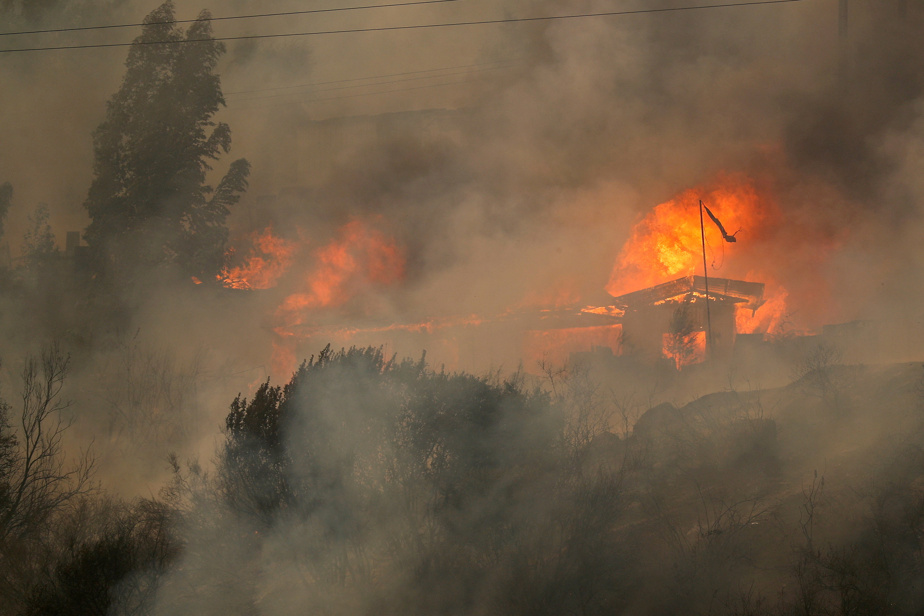After record heat in 2023, 2024 is off to a bad start: never before has a January been so hot and for the first time, the planet has exceeded the 1.5°C warming mark in 12 consecutive months compared to the pre-industrial era.
Between February 2023 and January 2024, the global surface air temperature was 1.52°C higher than the period 1850-1900, according to data from the European Copernicus Observatory.

PHOTO GAL ROMA, AFP
World map showing temperature anomalies recorded in January 2024 compared to the average January temperatures between 1981 and 2010, according to the European Copernicus Observatory.
“This does not mean that we have crossed the 1.5°C mark set in Paris” in 2015 to try to stop global warming and its consequences, recalls Richard Betts, director of studies on climate impacts at the office. British National Meteorological Survey.
For this to happen, this limit would need to be exceeded in a stable manner over several decades.
“Nevertheless, it is yet another reminder of the profound changes we have already made to our global climate and to which we must now adapt,” he added.
“Sharp warning”
“This is a stark warning about the urgency of action to limit climate change,” said Brian Hoskins, director of the Grantham Institute on Climate Change at Imperial College London.
“This is a very important and disastrous signal […]an alert to tell humanity that we are approaching the 1.5 degree limit faster than expected,” Johan Rockström of the Potsdam Institute for Research on the Impact of Climate told AFP. climate (PIK).
The current climate has already warmed by around 1.2°C compared to 1850-1900. And at the current rate of emissions, the IPCC predicts that the threshold of 1.5°C has a one in two chance of being reached on average by the years 2030-2035.
With an average temperature of 13.14°C, January 2024 is the hottest January on record since measurements began, after a record 2023.
This is 0.12°C higher than the previous record of January 2020 and 0.70°C above the normals for the period 1991-2020. And compared to the pre-industrial era, it’s 1,660°C warmer.
January is the 8the month in a row for which the monthly heat record is broken, underlines Copernicus.
The month was marked by a heat wave in South America, which recorded record temperatures and devastating fires in Colombia and Chile, with dozens of deaths in the Valparaiso region.
Despite some cold episodes and sometimes significant precipitation in certain parts of the globe, exceptional mildness was also noted in Spain and the south of France as well as in parts of the United States, Canada, Africa, of the Middle East and Central Asia.
2024, worse than 2023?
The surface of the oceans is also overheating, with a new record in January of 20.97°C average temperature.

PHOTO NALINI LEPETIT-CHELLA, AFP
Average daily ocean surface temperature each year since 1979, between parallels 60° north and 60° south, estimated by Copernicus.
This value is the second warmest for all months combined, less than 0.01°C from the previous record of August 2023 (20.98°C).
This heat continued beyond January 31, reaching new absolute records and exceeding the highest values of August 23 and 24, 2023, underlines Copernicus. And this, while the El Niño climatic phenomenon is slowing down in the equatorial Pacific, which should normally contribute to lowering the mercury a little.
The year 2024 “starts with a new record month”, laments Samantha Burgess, deputy head of the climate change department (C3S) at Copernicus. “A rapid reduction in greenhouse gas emissions is the only way to stop the rise in global temperatures.”
In mid-January, the World Meteorological Organization and the National Oceanic and Atmospheric Administration (NOAA) already warned that 2024 could well break the heat record set last year.
According to NOAA, there is a one in three chance that 2024 will be warmer than 2023, and a 99% chance that it will rank among the five hottest years in history.
However, Mr. Rockström believes, there is also a chance that, at the end of this “third super El Niño event” reinforced by human activity, temperatures “fall again as was the case in 2016 and 1998”.
